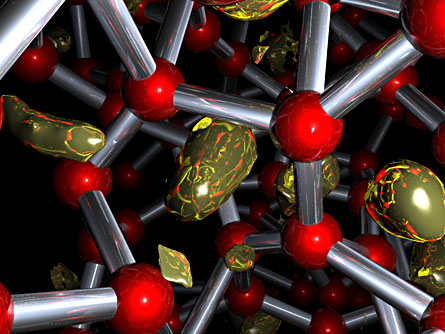- More than 2 years ago
Normal 0 false false false MicrosoftInternetExplorer4
The phrase “core chemistry” is taking on a meaning that’s definitely not mentioned in the standard curriculum, and which in fact goes against chemistry dogma.

Computer simulations suggest that at pressures approaching those at Earth’s center, lithium atoms begin to interact not just through their outermost electrons as in traditional chemistry, but also through their “core” electrons — those closer to the nucleus.
In an upcoming Physical Review Letters, Stanimir Bonev of Dalhousie University in Halifax, Canada and his collaborators describe how they used a supercomputer to calculate the behavior of lithium at pressures above 1.5 million atmospheres and temperatures as high as 3,000 kelvins (about 2,700° Celsius).
What they saw, they say, is a “unique state of matter,” the first case in which chemical structure is not determined solely by the outer electrons.
“Once one understands how to deal with this type of ‘core chemistry,’ one will also understand and discover, using computational methods, lots of new phases of matter under pressure,” comments computational physicist Giulia Galli of the University of California, Davis.
The simulated lithium started out as molten metal. As the researchers cranked up the pressure, the lithium atoms began to arrange themselves into pyramids. That’s similar to what happens in diamond, although in this case, the atoms didn’t stay put for long, and the pyramids kept forming and breaking up, so that the lithium stayed liquid and never became a solid.
In this new kind of liquid state, each atom held on tightly to its two core electrons, while each outer electron — lithium has only three electrons altogether — began to get stuck in a pair with other outer electrons in the spaces between ions.
The resulting structure was reminiscent of that of a salt, in which positive and negative ions alternate in an orderly crystal structure. Here, however, it was positively charged lithium ions (lithium atoms without their outer electrons) alternating with pairs of electrons.
Meanwhile, the enormous pressure squeezed the lithium to as little as two-thirds of the volume it would occupy at ambient pressure. As a result, the lithium ions got pressed onto one another, and the orbits of their core electrons began to change shape. Instead of being perfect spheres, they began looking more like the barbell-shaped orbits of the outermost electrons in elements such as carbon. It isn’t clear yet, however, exactly how core electrons of different atoms can interact.
Jeffrey Neaton, now at Lawrence Berkeley National Laboratory in California, and Neil Ashcroft of CornellUniversity had observed the first hints of lithium’s cores affecting one another through computer simulations they ran in 1999. Bonev says his team is also looking into similar effects in sodium and potassium.
Lithium is a metal. In metals, outer electrons normally are free to roam within the material, and thus to conduct electricity. But Bonev says that his team’s findings seem to explain trends seen in experiments done in 2001 by a Russian team and in 2002 by Marina Bastea of Lawrence Livermore National Laboratory in California and others.
Still, the ranges of pressures and temperatures simulated by Bonev and his team were not exactly the same as those of those experiments, Bastea says, so more work will need to be done to see if predictions match reality.
But for the time being, no, this won’t be in the test.







